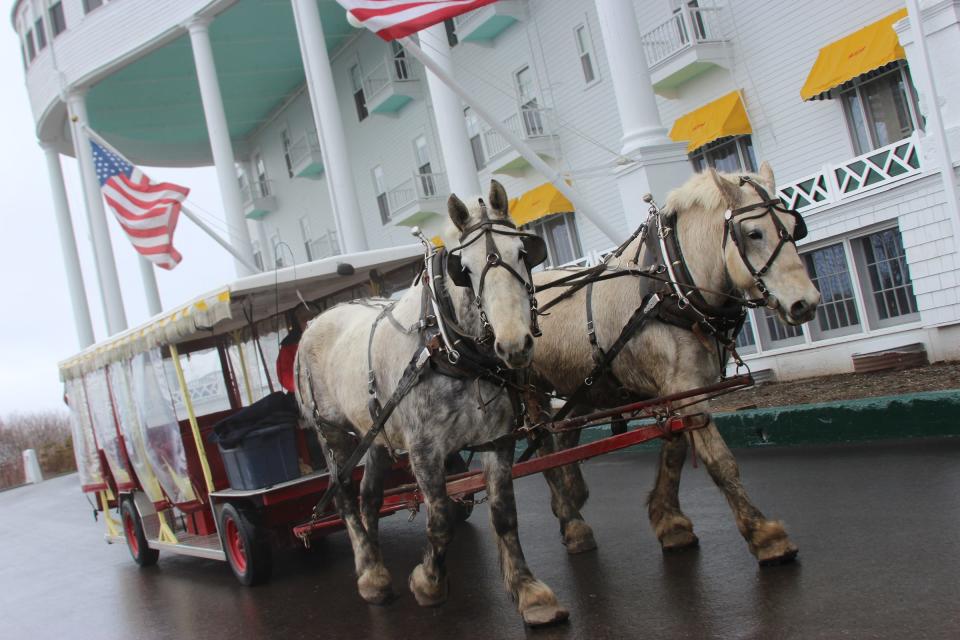Mackinac Island horse carriage driver still recovering 2 months after accident
A horse-and-buggy driver on Mackinac Island is still recovering two months after an accident involving spooked horses.
Police Chief Doug Topolski confirmed that something frightened a pair of horses, and they broke loose from the carriage boarding line on Main Street downtown on the morning of June 18. Topolski told the Free Press that the driver suffered serious injuries and has not returned to work.

In a video recirculating on social media, it appears the driver has been thrown from the carriage and is lying motionless on the street. The street is lined with shops on the historic island known for its charm and carriage rides. Automobiles are not allowed on the island.
At one point in the video clip, a woman is running and yells, "Get off the road!"
The video has been titled, "Mackinaw Island runaway horses and carriage." The island is spelled Mackinac. The mainland city is spelled Mackinaw.
The carriage, operated by one of the tour companies, was waiting in line to board passengers when one of the horses took off west down Main Street, Topolski said. "The horses broke the buggy pole, which connects the harness to the buggy. They ended up down near the Bicycle Street Inn and broke the light pole and then turned and hit a horse-hitching post, Topolski said.
"They were harnessed up at the time," he said. "Then the driver fell from the buggy and suffered serious injuries, including head injuries."
The horses were taken out of rotation and off the island, he said. They weren't injured. He declined to identify the driver.
"People need to know that horses can be spooked easily by something as benign as a plastic bag blowing across the road," Topolski said. "But the horses are well trained and acclimated to the island. Every once in a while, there's a rare event."
The horses on the island, strong Percheron and Belgians breeds primarily, weigh 1,500 to 2,000 pounds, he said.
"People need to know why we have rules downtown about bringing skateboards or training wheels," Topolski said. "We want to keep those away from the horses. This is not someplace for kids on training wheels. We have a different kind of traffic downtown."
More: Horses return to Mackinac Island for upcoming season
More: Mackinac Island hotel rooms already selling out for one special week in July 2024
Horses and island history
Mackinac Island a rich history dating back to the 1600s; its original Native American name interpreted by the French as Michilimackinac, means “Place of the Great Turtle," according to history posted at mackinacisland.org. Other notable facts from the site:
"While the Mayflower was bringing Pilgrims to New England in 1620, French explorers were venturing westward toward the Upper Great Lakes into what was then known as New France."
"By 1720, the Straits of Mackinac had become the primary transportation corridor in the Upper Great Lakes, fueling a vibrant fur trade that powered the economy of New France. Just five years earlier, to safeguard the fur trade, the French built Fort Michilimackinac on the mainland at the tip of Michigan’s Lower Peninsula, in what is now Mackinaw City."
"While the fur trade would remain the primary economic activity in the Straits well into the 19th Century, in just over 40 years the French would relinquish control of Fort Michilimackinac to the British following the French & Indian War."
"Even though the Americans declared independence in the 1770s, Mackinac Island by this time only recently had come under the control of the United States by treaty after the War of 1812. That war included the famous Battle of Mackinac when the British repelled an American attack on the grounds of what is now Wawashkamo Golf Course, the oldest golf course in Michigan."
"While the fur trade continued well into the 1800s, the military and economic significance of Fort Mackinac began to wane. By the latter half of the 19th Century, tourism began to emerge as the hallmark of Mackinac Island. Much of Mackinac Island was designated as a national park, staffed by soldiers from Fort Mackinac, and beautiful hotels and Victorian cottages began sprouting."
"In the 1920s, downtown shops innovated the brilliant techniques of demonstrating fudge making right in front of customers and using large ceiling fans to waft the sweet scent out into the street. And although R.E. Olds started churning out automobiles in Lansing two decades before, Mackinac Island banned cars – a distinctive characteristic that remains to this day."
Contact Phoebe Wall Howard: 313-618-1034 or phoward@freepress.com. Follow her on Twitter @phoebesaid.
This article originally appeared on Detroit Free Press: Mackinac Island horse carriage driver still recovering after accident

